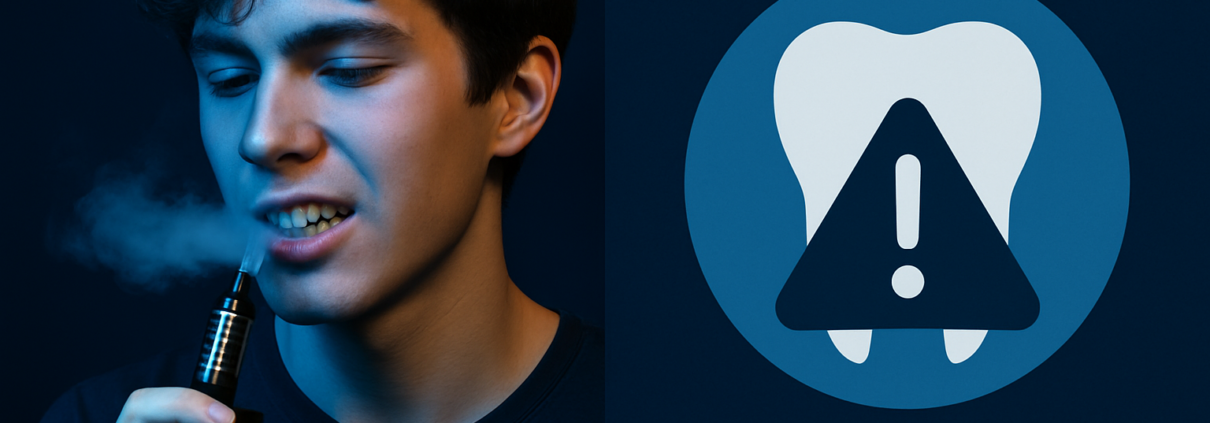You already know smoking is bad for your lungs. But what about your smile? From stained teeth and bad breath to gum disease and oral cancer, the impact of smoking and vaping on your oral health is more than cosmetic—it’s dangerous.
Vapes might seem like the “healthier” alternative to cigarettes, but when it comes to your gums and teeth, both are bad news. Nicotine and other chemicals in tobacco and e-cigarettes wreak havoc on your mouth’s ecosystem, turning it into a breeding ground for disease.
If you’re lighting up—or puffing clouds—it’s time to understand exactly what’s happening inside your mouth.
TLDR – Quick Guide
- Smoking and Vaping: Both expose your mouth to harmful chemicals that damage teeth and gums.
- Major Risks: Staining, bad breath, gum disease, tooth loss, and oral cancer.
- Vaping Isn’t Safe: E-cigarettes still deliver nicotine and other irritants that harm your gums.
- Why It Gets Missed: Nicotine masks early signs of disease, leading to late diagnoses.
- The Fix: Quitting and seeing your dentist regularly are the best defenses.
Detailed Breakdown
How Smoking Damages Your Mouth
Tobacco products are packed with toxins that directly impact oral tissues. Cigarettes, cigars, and smokeless tobacco all contain:
- Nicotine: A vasoconstrictor that reduces blood flow to your gums.
- Tar and Resin: Which stain enamel and contribute to tartar buildup.
- Carbon Monoxide and Carcinogens: That increase the risk of oral cancers.
Here’s what long-term use can do to your smile:
- Tooth Discoloration: Yellow and brown stains that brushing can’t fix.
- Persistent Bad Breath: Caused by dry mouth and bacteria buildup.
- Gum Disease: Smokers are up to 6x more likely to develop periodontitis.
- Slow Healing: After surgeries or injuries due to poor blood circulation.
- Oral Cancer: Especially in the tongue, lips, and throat.
Vaping: Not the “Safe” Alternative
E-cigarettes often get a pass in the wellness world, but let’s be clear: vaping still harms your mouth.
The aerosol from vapes contains nicotine, propylene glycol, formaldehyde, and heavy metals—not exactly what your gums need. Even without combustion, these chemicals:
- Dry out the mouth: Which increases risk of cavities and gum irritation.
- Trigger inflammation: Leading to redness, swelling, and bleeding gums.
- Alter oral bacteria: Creating imbalances that increase the risk of tooth decay and gum disease.
- Mask symptoms: Just like traditional nicotine, vape users may not notice gum issues until they’re severe.
A 2020 study in Science Advances found that e-cigarette users had bacterial profiles similar to people with advanced periodontal disease, even if they’d never smoked.
Why Nicotine Is So Deceptive
Nicotine doesn’t just get you hooked—it hides the symptoms of oral disease. It restricts blood vessels in your gums, which:
- Reduces visible bleeding (a common early warning sign).
- Delays your immune system’s response.
- Makes infections harder to detect and treat.
This means many smokers and vapers don’t realize they have gum disease until it’s already advanced.
The Long-Term Consequences
Let’s not sugarcoat it. If you continue smoking or vaping, here’s what you’re signing up for:
- Increased Risk of Tooth Loss: Gum disease is the leading cause of adult tooth loss, and smoking accelerates it.
- Dental Implant Failure: Smokers have significantly higher implant rejection rates.
- Jawbone Loss: Advanced gum disease can deteriorate the bone that supports your teeth.
- Costly Treatments: More cleanings, surgeries, and cosmetic repairs down the road.
What Your Dentist Can Do
Dentists are often the first to spot signs of smoking-related oral issues. If you’re a smoker or vaper, let them know. They can:
- Perform Oral Cancer Screenings: Early detection is key.
- Provide Deep Cleanings and Monitoring: To manage gum health.
- Recommend Quitting Support: From nicotine patches to counseling referrals.
- Offer Cosmetic Repairs: Whitening, veneers, or bonding for aesthetic concerns.
- Track Changes Over Time: With regular exams and digital imaging.
Pro tip: quitting now can reverse some damage, especially in the early stages of gum disease.
Key Takeaways
- Smoking and vaping are both major threats to your oral health.
- They increase the risk of stained teeth, bad breath, gum disease, and oral cancer.
- Nicotine hides early symptoms, making diseases harder to detect.
- Vaping is not a safe alternative—it carries its own set of oral health risks.
- Regular dental visits and quitting tobacco are your best defense.
FAQs
Does vaping cause less staining than smoking?
Yes, but it still causes discoloration over time due to chemical exposure—just at a slower rate.
Can I reverse damage if I quit smoking or vaping?
Some effects, like gum inflammation, can improve. But advanced issues like bone loss or tooth decay require professional treatment.
Is nicotine-free vaping safer for my teeth?
Removing nicotine helps, but other chemicals in vape juice can still irritate tissues and harm enamel.
What’s the best oral hygiene routine for smokers or vapers?
Brush twice a day, floss daily, use a fluoride mouthwash, and see your dentist every 3-4 months.
Should I tell my dentist I vape even if I think it’s minor?
Absolutely. Being honest helps your dentist tailor care and catch early warning signs.
We all know that dentists care about our teeth. But what if your dentist could also be the first to spot signs of heart disease, diabetes, or even autoimmune conditions? That’s the power of the oral-systemic health connection—a game-changer in modern healthcare that turns routine dental visits into potential lifesaving screenings.
Your mouth is more than a gateway to your body—it’s a mirror reflecting what’s happening beneath the surface. Dentists are increasingly trained to recognize the red flags of systemic illness by examining what’s going on in your gums, tongue, and saliva. Understanding this connection is critical not just for your dental hygiene, but your entire well-being.
TLDR – Quick Guide
- Oral-Systemic Health Connection: Your mouth can reflect systemic diseases like diabetes, heart disease, and more.
- Key Indicators: Inflammation, gum disease, dry mouth, and ulcers can all point to bigger health issues.
- Dentists’ Role: They can detect early symptoms and refer you for further testing.
- Why It’s Important: Early detection = better treatment outcomes.
- Bottom Line: Regular dental visits could be your first line of defense against chronic illness.
Detailed Breakdown
What is the Oral-Systemic Health Connection?
The oral-systemic health connection refers to the two-way relationship between oral health and overall body health. In simple terms: what happens in your mouth doesn’t stay in your mouth. Infections, inflammation, and changes in oral tissue can signal or even contribute to systemic diseases.
The American Academy for Oral Systemic Health (AAOSH) and other health organizations now emphasize the importance of integrating dental care with general healthcare. This is especially relevant in the context of chronic diseases that often start silently.
How Chronic Illness Shows Up in Your Mouth
Here’s how your body may be waving a red flag—through your mouth:
- Diabetes: Often causes dry mouth, gum infections, and slow healing. Dentists frequently identify undiagnosed cases through signs of periodontal disease.
- Heart Disease: Gum disease increases systemic inflammation, which is a major contributor to cardiovascular problems.
- Autoimmune Disorders: Conditions like lupus and Sjögren’s syndrome often manifest through oral ulcers or dry mouth.
- Osteoporosis: Jawbone density loss can be spotted in dental X-rays before a medical diagnosis.
- HIV/AIDS: Early oral signs include white lesions (thrush), severe gum disease, or herpes infections.
- Gastrointestinal Disorders: Conditions like Crohn’s disease may cause swelling, ulcers, and tissue inflammation in the mouth.
Your dentist is uniquely positioned to notice these subtle but serious symptoms—sometimes even before your primary care physician does.
Inflammation: The Common Denominator
At the heart of the oral-systemic link is inflammation. Periodontal disease is a chronic inflammatory condition, and chronic inflammation is a major driver of diseases like heart disease, Alzheimer’s, arthritis, and diabetes.
If your gums are constantly inflamed, your body is in a low-grade state of emergency. Bacteria and inflammatory markers can enter the bloodstream, affecting distant organs and systems. Managing gum disease is more than cosmetic—it’s critical to systemic health.
The Dentist’s Expanding Role in Health Screening
Modern dentists aren’t just cleaning teeth and filling cavities. They’re trained to recognize systemic clues and guide patients to further care. Here’s how:
- Medical Histories & Screenings: Including blood pressure checks, blood sugar monitoring, and medication reviews.
- Saliva Testing: Can detect inflammatory markers or bacteria associated with systemic illness.
- Tissue and Gum Analysis: Identifies abnormalities, infections, or lesions early.
- Referral Networks: Dentists collaborate with physicians, endocrinologists, and cardiologists when red flags arise.
Regular dental checkups have evolved into whole-body checkups, with your mouth as the starting point.
What You Can Do
To benefit from this connection:
- Keep Regular Dental Appointments: Don’t skip them—these visits are part of your overall preventive healthcare.
- Share Medical Updates with Your Dentist: Let them know about new diagnoses, medications, or symptoms.
- Ask About Saliva and Inflammation Testing: Some practices offer advanced diagnostics.
- Improve Your Oral Hygiene: Flossing and brushing aren’t just about cavities—they’re about systemic health, too.
- Advocate for Integrated Care: Encourage your healthcare providers to communicate with each other.
Key Takeaways
- The oral-systemic health connection is a vital bridge between dentistry and medicine.
- Your mouth often shows early signs of chronic conditions like diabetes, heart disease, and autoimmune disorders.
- Inflammation in the gums can fuel broader health problems if left untreated.
- Dentists are becoming crucial health allies through early detection and referrals.
- Taking care of your oral health is an investment in your total-body wellness.
FAQs
Can my dentist diagnose chronic diseases?
Dentists don’t officially diagnose conditions like diabetes or heart disease, but they can spot early warning signs and refer you to a physician for testing.
How often should I visit the dentist for optimal systemic health?
Twice a year is the general recommendation, but your dentist may suggest more frequent visits if you’re at higher risk.
What’s the link between gum disease and heart disease?
Chronic inflammation from gum disease can contribute to atherosclerosis (plaque buildup in arteries), increasing heart risk.
Are saliva tests at the dentist reliable for health screening?
Yes, some saliva tests can detect bacteria and inflammatory markers associated with both oral and systemic conditions.
Should I tell my dentist about medications and chronic conditions?
Absolutely. A full medical picture helps your dentist spot complications and tailor treatments safely.
It might start with a little toothache. Maybe you notice some swelling or feel a strange pressure when you bite down. But if that pain intensifies or you see a bump on your gums, you could be dealing with a dental abscess—a serious oral infection that should never be ignored.
This isn’t just a bad tooth day. A dental abscess can cause intense pain, jaw swelling, and even spread to other parts of your body if untreated. If you’re experiencing symptoms, your dentist should be the first person you call. Immediate treatment could save your tooth—and possibly your life.
TLDR – Quick Guide
- What is a Dental Abscess? A painful, pus-filled infection in or around a tooth.
- What Causes It? Usually untreated cavities, gum disease, or trauma.
- Symptoms to Watch: Throbbing pain, swelling, fever, bad taste, or a bump on the gums.
- Why It’s Dangerous: It can spread to your jaw, neck, or even brain if left untreated.
- Get Help Fast: Only a dentist can safely drain and treat an abscess.
Detailed Breakdown
What is a Dental Abscess?
A dental abscess is a pocket of pus caused by a bacterial infection, typically occurring in one of three areas:
- Periapical Abscess: At the tip of a tooth’s root, usually from deep decay or trauma.
- Periodontal Abscess: In the gums next to a tooth root, often linked to advanced gum disease.
- Gingival Abscess: On the surface of the gums, usually caused by foreign objects like food particles.
Regardless of the type, all dental abscesses are serious and require urgent care.
What Causes It?
Abscesses form when bacteria invade the dental pulp (the innermost part of your tooth), or the surrounding gum tissue. Common causes include:
- Untreated Tooth Decay
- Advanced Periodontal Disease
- Cracked or Broken Teeth
- Dental Procedures Gone Wrong
- Injuries or Foreign Bodies Lodged in the Gums
Once bacteria enter, the body’s immune system fights back by sending white blood cells to the site—leading to pus buildup, inflammation, and pain.
Symptoms of a Dental Abscess
Not all pain is created equal. Here are signs your toothache could be something more serious:
- Throbbing, persistent tooth pain
- Swelling in the cheek, face, or lymph nodes
- Fever or chills
- Sensitivity to hot or cold
- A bad taste in your mouth (from ruptured abscess)
- Difficulty opening your mouth or swallowing
- A visible pimple-like bump on your gums
These aren’t symptoms to tough out with an ice pack. They’re red flags for a potentially dangerous infection.
Why You Should Never Ignore One
Left untreated, an abscess won’t “go away on its own.” In fact, it can get worse—fast. Here’s what could happen:
- Bone Loss: Around the infected tooth or jawbone.
- Tooth Loss: The tooth may become non-restorable.
- Spread of Infection: To the jaw, neck, bloodstream, or brain—leading to sepsis, a potentially life-threatening condition.
- Airway Obstruction: Swelling in extreme cases can block airways or impact breathing.
Some of the worst cases begin as “just a toothache.” That’s why timing is everything when it comes to dental abscesses.
How Dentists Treat Dental Abscesses
Treatment depends on the severity, location, and cause—but the goal is always to eliminate the infection and save the tooth (if possible). Common treatments include:
- Draining the Abscess: Relieves pressure and removes pus.
- Root Canal Therapy: If the infection is inside the tooth.
- Tooth Extraction: If the tooth is beyond saving.
- Antibiotics: To help fight the infection, especially if it’s spreading.
- Pain Management: Through prescription or over-the-counter options.
Your dentist will also assess for any underlying issues—like gum disease or damaged fillings—that could have contributed to the infection.
Key Takeaways
- A dental abscess is a painful and dangerous oral infection that demands urgent care.
- It’s often caused by untreated tooth decay, gum disease, or trauma.
- Symptoms include swelling, fever, pain, and sometimes a visible pus-filled bump.
- Ignoring it can lead to serious health complications—even life-threatening ones.
- Early diagnosis and treatment from a dentist can prevent long-term damage.
FAQs
Can I treat a dental abscess at home?
No. While pain relief options like saltwater rinses or over-the-counter meds can help temporarily, only a dentist can treat the root cause.
How long can a dental abscess go untreated?
Even a few days can lead to serious complications. Always seek immediate dental care if symptoms appear.
Will antibiotics alone cure a dental abscess?
No. Antibiotics may help control the infection, but the source—like an infected pulp—must be treated or removed.
Is a dental abscess always painful?
Not necessarily. Some abscesses cause minimal pain but still carry serious health risks. Any swelling or gum bumps should be checked.
Can a tooth be saved after an abscess?
Often, yes—especially with prompt root canal therapy. But waiting too long may require extraction.



